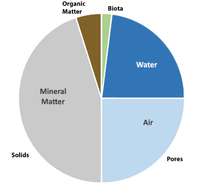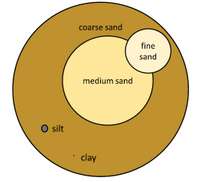 Like any living entity, plants require nutrients to live, grow, and reproduce. Those who live off the land know the importance of keeping soils healthy for crops to grow to their full potential. In figuring out how to do this, you must first understand how the condition of your soils affect the crops you produce.
Like any living entity, plants require nutrients to live, grow, and reproduce. Those who live off the land know the importance of keeping soils healthy for crops to grow to their full potential. In figuring out how to do this, you must first understand how the condition of your soils affect the crops you produce.
There are 3 main features that determine how a soil will function – mineral solids, soil organic matter, and pore size. The largest component of a soil is the mineral solids, which are characterized by their size: clay being the smallest particle and sand being the largest. The size of these mineral solids can determine how fast nutrients are exchanged as well as how much water a soil can hold or allow to filter through.
 Soil Organic Matter (SOM) are materials that originated from living organisms. They not only contribute nutrients to the soil, but also help determine how those nutrients move throughout the soil. Another important role both mineral and organic parts of soil play is in “carbon sequestration”.
Soil Organic Matter (SOM) are materials that originated from living organisms. They not only contribute nutrients to the soil, but also help determine how those nutrients move throughout the soil. Another important role both mineral and organic parts of soil play is in “carbon sequestration”.
This occurs when the organic matter binds with the mineral matter, preventing further release of carbon into the atmosphere. This plays a major role in helping to alleviate climate change by reducing carbon dioxide in the atmosphere.
The third soil feature to be mindful of is pore size. Pores are the spaces found in between the physical parts of soil and whose sizes are largely determined by the types of mineral matter you have. Clay soils have smaller pore sizes while sandy soils have larger pores (the larger the mineral solids, the larger the pore size). Pores are what allow for nutrient transfer, as well as movement of air, water, and microorganisms.
Soil health is so important, not only for agriculture but environmentalism as well. Healthy soils not only support healthy crops, but also sequester carbon, filter water, and can even detoxify harmful chemicals.
The materials for this article were taken from the Cornell “Comprehensive Assessment of Soil Health” which can be found through the ECHO community if you Click Here!
Reference
1Moebius-Clune, B.N., D.J. Moebius-Clune, B.K. Gugino, O.J. Idowu, R.R. Schindelbeck, A.J. Ristow, H.M. van Es, J.E. Thies, H.A. Shayler, M.B. McBride, K.S.M Kurtz, D.W. Wolfe, and G.S. Abawi, 2016. Comprehensive Assessment of Soil Health – The Cornell Framework, Edition 3.2, Cornell University, Geneva, NY.